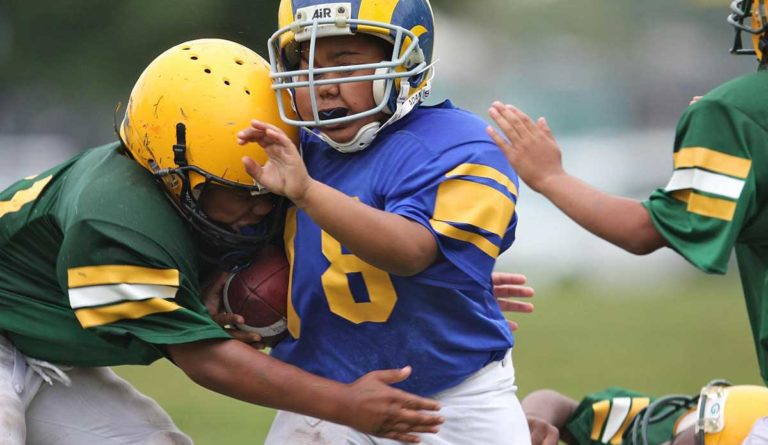Football, Concussions and Kids: How Young is too Young for Contact?
The consequences of repeated head trauma may be most severe for younger people with their still-developing brains.

Read Time: 4 minutes
Published:
The image is all too familiar: a football player lying motionless on the turf immobilized by a blow to the head. As troubling as this scene can be when the player is a full-grown professional or college athlete, the vast majority of the sport’s participants play in leagues at the high school level or below and are just as susceptible to traumatic brain injuries as their elder counterparts.
The consequences of repeated head trauma are dire for anyone, but they may be most severe for younger people with their still-developing brains. Children as young as five can participate in tackle football programs run by Pop Warner, the country’s largest youth football organization. These players may face serious risks from the hits they endure over the years says Cliff Robbins, the education and research programs manager at the Concussion Legacy Foundation.
“Between the ages of nine and twelve our brains are undergoing a massive amount of development,” Robbins says. “We know concussions during this time not only affect the brain’s ability to function at that time, but also impact development significantly. If we injure the brain during development, it’s likely that it will never reach its full potential. But we have no way to measure how severe that deficit is. That’s playing a very risky game with our most precious resource.”
The best solution, according to Robbins, is simply eliminating risk by keeping tackling out of the game until player’s brains are fully developed.
The consequences of repeated head trauma are dire for anyone, but they may be most severe for younger people with their still-developing brains.
“No one under the age of 14 should be playing tackle football,” he says. “We can limit a lot of the neuro-developmental consequences if we just raise the age of hitting. We’ve seen this in other sports. Soccer has increased the age of heading to 11. Hockey has increased the age of checking until 13. We can reduce a lot of concussions just by limiting who is playing.”
There has been some effort on the part of youth football organizations to reduce the risk of concussions by changing the way young players play the game. The sport’s official governing body, USA Football, has developed a program called Heads Up Football to promote player safety. The program seeks to combine proper equipment fitting, education about how to recognize and treat concussions for officials and coaches, and safer tackling practices to help reduce the rate of head trauma.
These practices have been adopted by over 6,300 youth leagues and 1,100 high school leagues according to Steve Alic, USA Football’s director of Communications. However, with over 15,000 high school leagues in America, the organization has a long way to go before these practices become ubiquitous.
“We don’t have authority to mandate leagues to adopt this program,” says Alic. “It’s a credit to these leagues’ commitment to the safety of their players that they’ve decided to adopt these guidelines.”
Even if these rules were to find wider acceptance, they are still lacking according to Robbins.
“Heads Up tackling operates on the idea that if we are able to tackle properly, we can make the game safer,” he says. “The thing is, it’s never really worked, and there’s no evidence that it actually helps reduce concussions. The football industry has, every 20 years or so, promoted this idea, that we can solve the head injury problem by tackling differently. But we can make much better greater gains by limiting the age at which contact is adopted. Football is a game that was designed for adult athletes. This phenomenon of five- and six-year-old tackle football leagues is fairly recent and, in my opinion, really inappropriate.”
Featured Image: Mike Hoff, Football 9.27, used under CC BY 2.0



